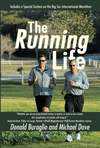Donald Buraglio and Michael Dove's Blog, page 25
July 10, 2011
100 Miles in Moccasins?
As my 100-miler rapidly approaches, one question I seem to be asked with increasing frequency is whether I'm going to wear my Soft Star moccasins on the mountain trails above Lake Tahoe. It also happens to be the same question I've been asking myself since the beginning of the year.
Shortly after I signed up for the race in January, I thought the notion of running the entire race in a pair of moccasins was pretty cool - however, I wasn't quite certain that my body was up to the task. Despite the fact that I've been a barefoot and minimalist runner for two years now, the longest distance I had covered in minimalist footwear was 50 miles. There's really no way of knowing what physical issues (foot related or otherwise) lay beyond that distance until you've been actually there a few times … and even then, it's something of a dice roll. Will my calves start cramping on me? Will my feet and ankles handle the long-term pounding? I honestly can't say for sure.
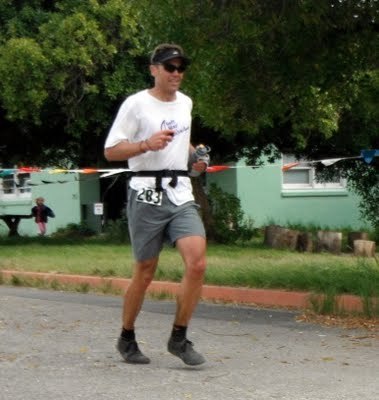
Finishing the Miwok 100K in RunAmocs (photo courtesy of Gretchen)
It's also worth noting that more than two full years have passed since my last 100-mile race – and to give you a sense of what sort of transformation took place in that time period, consider what I wore in my previous 100-milers: La Sportiva Wildcats and Montrail Hardrocks. In that regard, my training regimen leading up to this year's 100-miler wasn't just a matter of returning to a place my body had been before; the whole minimalist aspect made it feel as if I was preparing for the distance for the first time all over again.
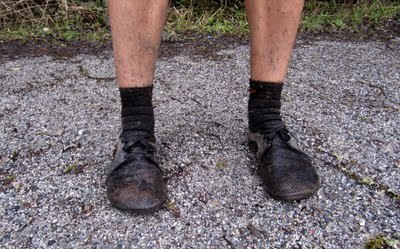
RunAmoc Dashes (and Drymax socks) after 50 wet and muddy miles at Woodside
Nevertheless, I cemented a goal in my head of running the Tahoe Rim Trail 100 in moccasins, then spent the entire spring and summer simultaneously working towards it and constantly reassessing to see if it was feasible. Throughout the process, there were two primary motivating factors involved: one was to make a general statement about minimalist running, and the other was to bring more focused attention to the Soft Star company that manufacturers my moccasins.
The general statement is relatively straightforward: no matter how many miles I (or, for that matter, anyone else) run in minimalist footwear, there will always be a faction of the trail and ultrarunning communities who respond – either out loud, or just internally – with something like, Sure, but can you run 100 miles in them? You need REAL shoes to run the big ultras. So running 100 in my mocs is the most convincing way to put that argument to rest.
(Incidentally, there's a similar mindset about technicality of terrain for minimalists; in other words, unless I do 100 miles on lava rocks and cactus quills, someone will inevitably dismiss the Tahoe trails as "easy" enough to go minimalist. There's really no way to sway this mindset aside from running on every trail surface all over the world, so I've decided to not let this sort of skepticism bother me. But I guarantee you it's out there.)
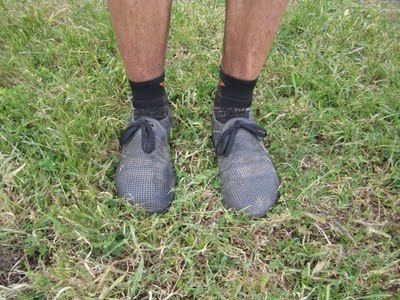
Original RunAmocs after Miwok 100K
While I'm far from the first person to do a 100-miler in minimalist shoes, it's still seen as kind of a freak thing. My hope is that as one person here and another person there accomplishes the task, conventional wisdom will gradually evolve to understand that minimalism is just another style of shoe preference, one which doesn't inherently place the runner at risk or disadvantage.
The second point is something that shouldn't surprise anyone who's familiar with this website: I absolutely love the Soft Star company. I love the way they've embraced the minimalist running movement, and I love how they treat each customer like a VIP client. I also have a soft (pardon the pun) spot for small companies who have a clear mission and do things the right way, and Soft Star is one of the best examples that you'll ever encounter. If you need more convincing of this, check out this public radio profile of the company from this spring, as well as the video I've embedded below for a better appreciation of what the company's all about.
I've been running in the RunAmoc for more than a year now, and I've often described it as my favorite minimalist shoe. It may surprise you, then, to hear one secret I haven't ever disclosed: I don't think the RunAmoc is the best overall minimalist shoe on the market. I've tested other shoes that clearly have better durability, or better traction, or a better fit. However, none of those give me the pure primal joy that I feel when running through some remote trail with a pair of moccasins on my feet. And when you're running 100 miles in something, you'd better be able to find the pleasure in it.
Early in the spring, I discussed my plan with the Soft Star elves, and they were completely on board. What impressed me the most is that back then, it wasn't a sure thing that I'd even wear my mocs at Tahoe – it was more of a "I'm going to test this out for a few months to see if it works" proposal. I wasn't certain if I'd wear the original RunAmoc, or the new Dash, or even some other company's shoe if the moccasin testing didn't go well, and they were 100% supportive of my efforts anyway, no matter how it turned out. They even ordered me the cool logo shirt that I've taken to wearing at my races this year.
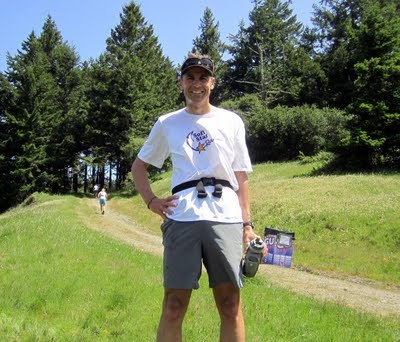
Team Soft Star at Miwok
Fortunately, each of my tune-up races has gone quite well from a footwear perspective, so I feel as comfortable as possible about lining up at the big dance in Tahoe with my RunAmocs. I'm going with the original lite version, which are still my favorite over the Dash or the Moc3 for trail running. Obviously there's no guarantee that the mocs will carry me to success, but I'm confident that my choice of footwear won't be a huge determining factor in my ability to reach the finish line. And I'm absolutely certain that no other shoe could help me enjoy the experience more.
"Soft Star Shoes: Local Roots, Global Reach", (click to play):
Get updates as soon as they're posted! Click here to subscribe to Running and Rambling.
Check out the Running Life book for a collection of our most popular columns.

Shortly after I signed up for the race in January, I thought the notion of running the entire race in a pair of moccasins was pretty cool - however, I wasn't quite certain that my body was up to the task. Despite the fact that I've been a barefoot and minimalist runner for two years now, the longest distance I had covered in minimalist footwear was 50 miles. There's really no way of knowing what physical issues (foot related or otherwise) lay beyond that distance until you've been actually there a few times … and even then, it's something of a dice roll. Will my calves start cramping on me? Will my feet and ankles handle the long-term pounding? I honestly can't say for sure.

Finishing the Miwok 100K in RunAmocs (photo courtesy of Gretchen)
It's also worth noting that more than two full years have passed since my last 100-mile race – and to give you a sense of what sort of transformation took place in that time period, consider what I wore in my previous 100-milers: La Sportiva Wildcats and Montrail Hardrocks. In that regard, my training regimen leading up to this year's 100-miler wasn't just a matter of returning to a place my body had been before; the whole minimalist aspect made it feel as if I was preparing for the distance for the first time all over again.

RunAmoc Dashes (and Drymax socks) after 50 wet and muddy miles at Woodside
Nevertheless, I cemented a goal in my head of running the Tahoe Rim Trail 100 in moccasins, then spent the entire spring and summer simultaneously working towards it and constantly reassessing to see if it was feasible. Throughout the process, there were two primary motivating factors involved: one was to make a general statement about minimalist running, and the other was to bring more focused attention to the Soft Star company that manufacturers my moccasins.
The general statement is relatively straightforward: no matter how many miles I (or, for that matter, anyone else) run in minimalist footwear, there will always be a faction of the trail and ultrarunning communities who respond – either out loud, or just internally – with something like, Sure, but can you run 100 miles in them? You need REAL shoes to run the big ultras. So running 100 in my mocs is the most convincing way to put that argument to rest.
(Incidentally, there's a similar mindset about technicality of terrain for minimalists; in other words, unless I do 100 miles on lava rocks and cactus quills, someone will inevitably dismiss the Tahoe trails as "easy" enough to go minimalist. There's really no way to sway this mindset aside from running on every trail surface all over the world, so I've decided to not let this sort of skepticism bother me. But I guarantee you it's out there.)

Original RunAmocs after Miwok 100K
While I'm far from the first person to do a 100-miler in minimalist shoes, it's still seen as kind of a freak thing. My hope is that as one person here and another person there accomplishes the task, conventional wisdom will gradually evolve to understand that minimalism is just another style of shoe preference, one which doesn't inherently place the runner at risk or disadvantage.
The second point is something that shouldn't surprise anyone who's familiar with this website: I absolutely love the Soft Star company. I love the way they've embraced the minimalist running movement, and I love how they treat each customer like a VIP client. I also have a soft (pardon the pun) spot for small companies who have a clear mission and do things the right way, and Soft Star is one of the best examples that you'll ever encounter. If you need more convincing of this, check out this public radio profile of the company from this spring, as well as the video I've embedded below for a better appreciation of what the company's all about.
I've been running in the RunAmoc for more than a year now, and I've often described it as my favorite minimalist shoe. It may surprise you, then, to hear one secret I haven't ever disclosed: I don't think the RunAmoc is the best overall minimalist shoe on the market. I've tested other shoes that clearly have better durability, or better traction, or a better fit. However, none of those give me the pure primal joy that I feel when running through some remote trail with a pair of moccasins on my feet. And when you're running 100 miles in something, you'd better be able to find the pleasure in it.
Early in the spring, I discussed my plan with the Soft Star elves, and they were completely on board. What impressed me the most is that back then, it wasn't a sure thing that I'd even wear my mocs at Tahoe – it was more of a "I'm going to test this out for a few months to see if it works" proposal. I wasn't certain if I'd wear the original RunAmoc, or the new Dash, or even some other company's shoe if the moccasin testing didn't go well, and they were 100% supportive of my efforts anyway, no matter how it turned out. They even ordered me the cool logo shirt that I've taken to wearing at my races this year.

Team Soft Star at Miwok
Fortunately, each of my tune-up races has gone quite well from a footwear perspective, so I feel as comfortable as possible about lining up at the big dance in Tahoe with my RunAmocs. I'm going with the original lite version, which are still my favorite over the Dash or the Moc3 for trail running. Obviously there's no guarantee that the mocs will carry me to success, but I'm confident that my choice of footwear won't be a huge determining factor in my ability to reach the finish line. And I'm absolutely certain that no other shoe could help me enjoy the experience more.
"Soft Star Shoes: Local Roots, Global Reach", (click to play):
Get updates as soon as they're posted! Click here to subscribe to Running and Rambling.
Check out the Running Life book for a collection of our most popular columns.

Published on July 10, 2011 22:25
July 9, 2011
Random Shots of Beauty
Reaching back to last summer for this one ...

I confess to being somewhat distracted with thoughts of the Sierra Nevada Mountains lately, most likely because this race is now less than one week away. Good heavens.
More on this to come during the week.
Get updates as soon as they're posted! Click here to subscribe to Running and Rambling.
Check out the Running Life book for a collection of our most popular columns.


I confess to being somewhat distracted with thoughts of the Sierra Nevada Mountains lately, most likely because this race is now less than one week away. Good heavens.
More on this to come during the week.
Get updates as soon as they're posted! Click here to subscribe to Running and Rambling.
Check out the Running Life book for a collection of our most popular columns.

Published on July 09, 2011 09:37
July 7, 2011
Mountain Hardwear Fluid 26 Backpack Review
Administrative note: When it comes to trail gear, summertime means hydration, and finding the right fluid delivery system for your activity. Accordingly, I have a few reviews lined up this month; two of them are relatives of CamelBak and Nathan models that I've tested previously (back when I was doing this comprehensive hydration pack comparison), and today's represents a different category of pack which is more appropriate for hiking than trail running. It's a product I'm really happy with, so if you're like me and do a lot of day hiking in addition to running, read on.
**
Somewhere near the top of Yosemite Falls, my father-in-law provided the inspiration for this review.
It was early springtime, on one of those Yosemite days where the weather was completely unpredictable: it could be wet or freezing in the canyons, sunny and hot on the exposed granite faces, or most likely, both. We had a long hike planned with three kids, meaning that we had no idea how many hours we'd be on the trail. Each of us was carrying extra food, supplies, and first aid items for the rest of the group. And it was during one of the clothing layer changes or gear swaps that he turned to me and said, Are you ever going to review any bigger packs? I need more space to carry all this stuff.

Mountain Hardwear Fluid 26 backpack
He and I, along with everyone else in our group, were wearing standard hydration packs with 40 to 100oz of fluid and 100 to 900 cubic inches of cargo capacity (his was a CamelBak XCT, mine was the GoLite Rush). For the vast majority of my hikes, these packs work just fine, but my father in law was right: sometimes, you need a lot more space. For those occasions, day packs like the Mountain Hardware Fluid 26 would be ideal.
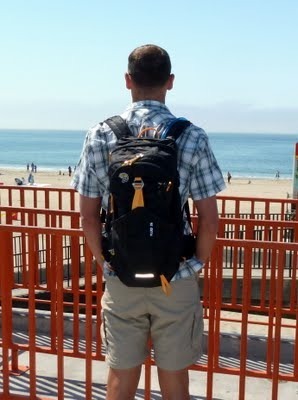
Chilling at the Santa Cruz Beach Boardwalk
The Fluid 26 is packed with features, but the two most two most important ones are right there in the name: the pack is compatible with fluid reservoirs, and it has 26L (nearly 1600 cubic inches) of cargo capacity. Material construction is 100-denier ripstop nylon for the body, with 315-denier Cordura nylon on the bottom. Its dimensions are 21" x 11" x 11", with an empty weight of 2.0 lb. There are pockets all over the place which make organization a breeze, as well as structure and design elements that provide a comfortable ride even with a full load over several hours of use. I've worn it for day hikes on the trail as well as for two days worth of "urban adventure" at Bay Area theme parks, and it's proven to be very functional and versatile in both cases.

Fluid reservoir pocket with top clip
Like other hydration-compatible day packs, the Fluid 26 doesn't come with its own fluid reservoir; rather, you're free to use whatever size reservoir you need for the conditions. The two I've used most frequently are a 70-oz CamelBak bladder, and a Hydrapak 100-oz reservoir; both of them fit easily into their own zipper-free compartment right against the back, and there's a top clip to keep the reservoir vertical as the fluid drains. One minor drawback is that there isn't a routing tunnel through either of the shoulder straps, but my tubes stayed in place very well once they were tucked into the sternal strap in front.

HardWave framesheet, ColdWave raised foam
On the back framesheet (the main panel against your back), Mountain Hardware uses a technology called HardWave, which basically means the shape is thermo-formed to stay straight rather than becoming rounded after long-term use, with ridges like an accordion to preserve vertical flexibility along the length of the torso. This is combined with a CoolWave design of raised ventilated foam that creates natural air channels between your back and the framesheet, decreasing heat and perspiration on your backside. This same ventilated foam is present (but thinner) on the main straps as well, providing a very soft interface coming over the top of your shoulder.
In addition to a small sternum strap, two larger side straps attach at the abdomen; these are comprised of two zippered mesh pockets that are large enough for cameras, energy bars, GPS devices, or phones. The side straps also incorporate Mountain Hardwear's OTF (On The Fly) Compression design which allow you to adjust the overall tension of the pack against your body with a simple pull or release on each side.

Pockets inside of pockets: mesh and zipper pockets inside main compartment
As for the pockets: there's absolutely no problem packing everything you'll need to spend an entire day on the trail. There are two large primary zippered cargo compartments that run the length of the pack, one of which has smaller mesh pockets inside for storage of keys or small valuables, and a zip organizer pocket for credit cards or a wallet.

Small top pocket with fleece sunglass pocket
There's a smaller top zippered compartment for quick access items, which also includes a fleece-lined pocket for sunglasses.
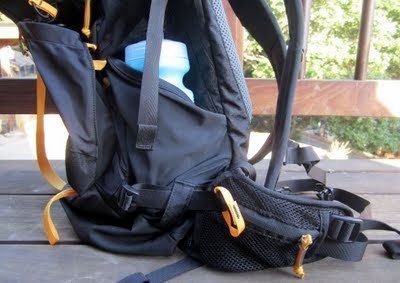
Zippered side pocket, OTF Compression pull (yellow ring), stretch-woven side pocket with 20-oz water bottle inside
Each side has two stretch woven unzippered side pockets for water bottles or similar-shaped items. On top of it all is an open pleated strap-secured pocket that is the perfect size for a bike helmet or a lightweight jacket.

Pockets and pockets and pockets ...
Basically, if you need to haul more stuff than you can fit into the Fluid 26 for a day hike, you're doing it wrong. It's an ideal pack for planned all-day outings, or if you happen to be the designated pack mule for a group of trail companions on a shorter outing. And the next time we take the whole family to Yosemite, this pack is definitely making the trip.
The Mountain Hardwear Fluid 26 pack retails for $110 from TravelCountry.com.

*Product provided by TravelCountry.com.
**See other product reviews on sidebar at right. If you have a product you'd like reviewed, contact me at info@runningandrambling.com.
Get updates as soon as they're posted! Click here to subscribe to Running and Rambling.
Check out the Running Life book for a collection of our most popular columns.

**
Somewhere near the top of Yosemite Falls, my father-in-law provided the inspiration for this review.
It was early springtime, on one of those Yosemite days where the weather was completely unpredictable: it could be wet or freezing in the canyons, sunny and hot on the exposed granite faces, or most likely, both. We had a long hike planned with three kids, meaning that we had no idea how many hours we'd be on the trail. Each of us was carrying extra food, supplies, and first aid items for the rest of the group. And it was during one of the clothing layer changes or gear swaps that he turned to me and said, Are you ever going to review any bigger packs? I need more space to carry all this stuff.

Mountain Hardwear Fluid 26 backpack
He and I, along with everyone else in our group, were wearing standard hydration packs with 40 to 100oz of fluid and 100 to 900 cubic inches of cargo capacity (his was a CamelBak XCT, mine was the GoLite Rush). For the vast majority of my hikes, these packs work just fine, but my father in law was right: sometimes, you need a lot more space. For those occasions, day packs like the Mountain Hardware Fluid 26 would be ideal.

Chilling at the Santa Cruz Beach Boardwalk
The Fluid 26 is packed with features, but the two most two most important ones are right there in the name: the pack is compatible with fluid reservoirs, and it has 26L (nearly 1600 cubic inches) of cargo capacity. Material construction is 100-denier ripstop nylon for the body, with 315-denier Cordura nylon on the bottom. Its dimensions are 21" x 11" x 11", with an empty weight of 2.0 lb. There are pockets all over the place which make organization a breeze, as well as structure and design elements that provide a comfortable ride even with a full load over several hours of use. I've worn it for day hikes on the trail as well as for two days worth of "urban adventure" at Bay Area theme parks, and it's proven to be very functional and versatile in both cases.

Fluid reservoir pocket with top clip
Like other hydration-compatible day packs, the Fluid 26 doesn't come with its own fluid reservoir; rather, you're free to use whatever size reservoir you need for the conditions. The two I've used most frequently are a 70-oz CamelBak bladder, and a Hydrapak 100-oz reservoir; both of them fit easily into their own zipper-free compartment right against the back, and there's a top clip to keep the reservoir vertical as the fluid drains. One minor drawback is that there isn't a routing tunnel through either of the shoulder straps, but my tubes stayed in place very well once they were tucked into the sternal strap in front.

HardWave framesheet, ColdWave raised foam
On the back framesheet (the main panel against your back), Mountain Hardware uses a technology called HardWave, which basically means the shape is thermo-formed to stay straight rather than becoming rounded after long-term use, with ridges like an accordion to preserve vertical flexibility along the length of the torso. This is combined with a CoolWave design of raised ventilated foam that creates natural air channels between your back and the framesheet, decreasing heat and perspiration on your backside. This same ventilated foam is present (but thinner) on the main straps as well, providing a very soft interface coming over the top of your shoulder.
In addition to a small sternum strap, two larger side straps attach at the abdomen; these are comprised of two zippered mesh pockets that are large enough for cameras, energy bars, GPS devices, or phones. The side straps also incorporate Mountain Hardwear's OTF (On The Fly) Compression design which allow you to adjust the overall tension of the pack against your body with a simple pull or release on each side.

Pockets inside of pockets: mesh and zipper pockets inside main compartment
As for the pockets: there's absolutely no problem packing everything you'll need to spend an entire day on the trail. There are two large primary zippered cargo compartments that run the length of the pack, one of which has smaller mesh pockets inside for storage of keys or small valuables, and a zip organizer pocket for credit cards or a wallet.

Small top pocket with fleece sunglass pocket
There's a smaller top zippered compartment for quick access items, which also includes a fleece-lined pocket for sunglasses.

Zippered side pocket, OTF Compression pull (yellow ring), stretch-woven side pocket with 20-oz water bottle inside
Each side has two stretch woven unzippered side pockets for water bottles or similar-shaped items. On top of it all is an open pleated strap-secured pocket that is the perfect size for a bike helmet or a lightweight jacket.

Pockets and pockets and pockets ...
Basically, if you need to haul more stuff than you can fit into the Fluid 26 for a day hike, you're doing it wrong. It's an ideal pack for planned all-day outings, or if you happen to be the designated pack mule for a group of trail companions on a shorter outing. And the next time we take the whole family to Yosemite, this pack is definitely making the trip.
The Mountain Hardwear Fluid 26 pack retails for $110 from TravelCountry.com.

*Product provided by TravelCountry.com.
**See other product reviews on sidebar at right. If you have a product you'd like reviewed, contact me at info@runningandrambling.com.
Get updates as soon as they're posted! Click here to subscribe to Running and Rambling.
Check out the Running Life book for a collection of our most popular columns.

Published on July 07, 2011 21:25
July 5, 2011
Saucony Hattori Review
If nothing else, you have to give Saucony credit for persistence.
They were one of the first major shoe manufacturers to actively court the minimalist movement; unfortunately, they also came across as somewhat disingenuous in their aggressive marketing of the 18mm-at-the-heel Kinvara as a minimalist shoe, which got them off on the wrong foot, so to speak, with a lot of minimalist fans. When I eventually reviewed the Kinvara, I concluded that it was a pretty decent shoe for its light weight and more natural biomechanics, and it ultimately became a fairly popular transitional shoe.

Saucony Hattori
Saucony kept progressing with the minimalist model, releasing an updated Kinvara 2 this spring – basically the original Kinvara with some modifications to the upper material – as well as the Hattori, which is a true zero-drop, super lightweight road shoe that can legitimately claim to be a true minimalist offering. It's sort of odd, then, that the hype surrounding the Hattori has been relatively subdued; in my opinion, the structure and design innovations on the Hattori are far more significant than those on the Kinvara. Back when Saucony was heavily promoting the Kinvara, my expectation was that the shoe would turn out to be something more like the Hattori – but better late than never, I guess.
Honestly, I haven't really fallen in love with the Hattori because it's primarily a road shoe, and also because of a couple of issues I'll detail soon. However, with vital specs of 13mm heel height, zero drop to forefoot, and 4.4oz per shoe, there's no question that Saucony is trending in the right direction here, and the shoe is certainly worth a closer look. So let's get to the review.
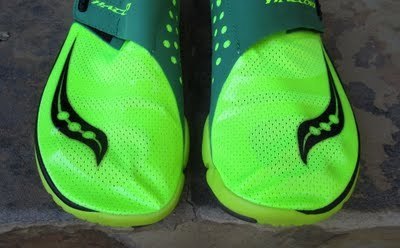
Very thin mesh fabric upper
Uppers of the Hattori are composed of a very thin stretch mesh fabric, with a toe-box shape that the website describes as a "mitten-like" fit (apparently the word "glove" has been a bit overused recently). The idea was to have a sock-like (or possibly neoprene-like) fit, but I found the overall dimensions to be uncomfortably restrictive, especially on the lateral aspect where my pinky toe presses into the 4th toe. This has as much to do with the shape of the last as with the cut of the upper, but the end result was that I didn't have any toe splay upon foot strike, which is a bad mark in my book. If you have narrow feet, it may not be a problem.

Power rings sold separately
While we're at it, one small tangent about the uppers: if you happened to be as startled as I was about the Green Lantern hue of my test pair, I should point out that the Hattori comes in five different colors. Just so you know.

Upper fastener strap
Echoing Vibram's Komodo Sport, the Hattori doesn't have any fastening system for the upper aside from two strategically placed straps: one across the top of the midfoot, and one behind the heel. Unfortunately, just like the Komodo, I found the straps to be largely ineffective; while the top strap provides a bit of extra tension, the heel strap doesn't help improve either the fit of the heelcup or the stability of the heel on top of the insole. My tendency is to roll to the inside part of my heel after midfoot strike, and with the Hattori, I ended up off the side of the insole like I do in my moccasins, rather than remain in place like I do with my Merrell Trail Gloves.

EVA (green) and rubber (gray) outsole
On the underside of the shoe, Saucony decided to go with nearly 100% EVA construction; there's no reinforced rubber aside from the gray areas you see above. Considering that this is intended as a minimalist shoe, the placement of the rubber seems a bit odd – at the very least, the reinforcement at the forefoot area should be significantly larger.

Excellent heel to toe flexibility
The advantages of using straight EVA without rubber reinforcement are that it decreases weight and improves overall flexibility; indeed, the Hattori is completely flexible from heel to toe. The disadvantages are that it has poor traction, gives an overly cushioned ground feel, and wears down quickly. The Hattori is intended strictly as a road or track shoe, but I've worn it on several runs on fire roads to test its grip in the gravel and dirt. Simply put, there isn't much there – and the thickness of the midsole is too much for me to enhance traction by gripping with my toes like I do in Vibrams or Soft Stars.

Rear heel straps
Since I do 95% of my running on the dirt, the lack of traction is obviously a significant downside for my everyday use. Conversely, I suspect that high-mileage road runners would wear the EVA down relatively quickly, although I probably won't be the best judge of long-term durability because I won't log enough road miles in the near future to find out. (As of this review, I only have about 50 total miles on my pair – approximately 40 on dirt and 10 on roads). If anyone out there has high road miles and can weigh in on this in the comments below, I'll update this post accordingly.

I suppose the final verdict for recommending the Hattori depends on your intended use. If you're a dedicated road or track runner looking for a barely-there shoe to do some speed work or to blaze a PR in your next 5K or 10K, the Hattori could make a nice addition to your shoe lineup. If you're looking for a durable everyday trainer or a general all-purpose road and trail shoe, there are certainly more suitable minimalist models out there. However, I hope that Saucony keeps innovating and trying new ideas - particularly a trail-friendly true minimalist model – and that the Hattori ends up being the next stage in a progression toward more impressive things to come.
Saucony's Hattori retails for $80 from REI.com and other online vendors.

Get updates as soon as they're posted! Click here to subscribe to Running and Rambling.
Check out the Running Life book for a collection of our most popular columns.

They were one of the first major shoe manufacturers to actively court the minimalist movement; unfortunately, they also came across as somewhat disingenuous in their aggressive marketing of the 18mm-at-the-heel Kinvara as a minimalist shoe, which got them off on the wrong foot, so to speak, with a lot of minimalist fans. When I eventually reviewed the Kinvara, I concluded that it was a pretty decent shoe for its light weight and more natural biomechanics, and it ultimately became a fairly popular transitional shoe.

Saucony Hattori
Saucony kept progressing with the minimalist model, releasing an updated Kinvara 2 this spring – basically the original Kinvara with some modifications to the upper material – as well as the Hattori, which is a true zero-drop, super lightweight road shoe that can legitimately claim to be a true minimalist offering. It's sort of odd, then, that the hype surrounding the Hattori has been relatively subdued; in my opinion, the structure and design innovations on the Hattori are far more significant than those on the Kinvara. Back when Saucony was heavily promoting the Kinvara, my expectation was that the shoe would turn out to be something more like the Hattori – but better late than never, I guess.
Honestly, I haven't really fallen in love with the Hattori because it's primarily a road shoe, and also because of a couple of issues I'll detail soon. However, with vital specs of 13mm heel height, zero drop to forefoot, and 4.4oz per shoe, there's no question that Saucony is trending in the right direction here, and the shoe is certainly worth a closer look. So let's get to the review.

Very thin mesh fabric upper
Uppers of the Hattori are composed of a very thin stretch mesh fabric, with a toe-box shape that the website describes as a "mitten-like" fit (apparently the word "glove" has been a bit overused recently). The idea was to have a sock-like (or possibly neoprene-like) fit, but I found the overall dimensions to be uncomfortably restrictive, especially on the lateral aspect where my pinky toe presses into the 4th toe. This has as much to do with the shape of the last as with the cut of the upper, but the end result was that I didn't have any toe splay upon foot strike, which is a bad mark in my book. If you have narrow feet, it may not be a problem.

Power rings sold separately
While we're at it, one small tangent about the uppers: if you happened to be as startled as I was about the Green Lantern hue of my test pair, I should point out that the Hattori comes in five different colors. Just so you know.

Upper fastener strap
Echoing Vibram's Komodo Sport, the Hattori doesn't have any fastening system for the upper aside from two strategically placed straps: one across the top of the midfoot, and one behind the heel. Unfortunately, just like the Komodo, I found the straps to be largely ineffective; while the top strap provides a bit of extra tension, the heel strap doesn't help improve either the fit of the heelcup or the stability of the heel on top of the insole. My tendency is to roll to the inside part of my heel after midfoot strike, and with the Hattori, I ended up off the side of the insole like I do in my moccasins, rather than remain in place like I do with my Merrell Trail Gloves.

EVA (green) and rubber (gray) outsole
On the underside of the shoe, Saucony decided to go with nearly 100% EVA construction; there's no reinforced rubber aside from the gray areas you see above. Considering that this is intended as a minimalist shoe, the placement of the rubber seems a bit odd – at the very least, the reinforcement at the forefoot area should be significantly larger.

Excellent heel to toe flexibility
The advantages of using straight EVA without rubber reinforcement are that it decreases weight and improves overall flexibility; indeed, the Hattori is completely flexible from heel to toe. The disadvantages are that it has poor traction, gives an overly cushioned ground feel, and wears down quickly. The Hattori is intended strictly as a road or track shoe, but I've worn it on several runs on fire roads to test its grip in the gravel and dirt. Simply put, there isn't much there – and the thickness of the midsole is too much for me to enhance traction by gripping with my toes like I do in Vibrams or Soft Stars.

Rear heel straps
Since I do 95% of my running on the dirt, the lack of traction is obviously a significant downside for my everyday use. Conversely, I suspect that high-mileage road runners would wear the EVA down relatively quickly, although I probably won't be the best judge of long-term durability because I won't log enough road miles in the near future to find out. (As of this review, I only have about 50 total miles on my pair – approximately 40 on dirt and 10 on roads). If anyone out there has high road miles and can weigh in on this in the comments below, I'll update this post accordingly.

I suppose the final verdict for recommending the Hattori depends on your intended use. If you're a dedicated road or track runner looking for a barely-there shoe to do some speed work or to blaze a PR in your next 5K or 10K, the Hattori could make a nice addition to your shoe lineup. If you're looking for a durable everyday trainer or a general all-purpose road and trail shoe, there are certainly more suitable minimalist models out there. However, I hope that Saucony keeps innovating and trying new ideas - particularly a trail-friendly true minimalist model – and that the Hattori ends up being the next stage in a progression toward more impressive things to come.
Saucony's Hattori retails for $80 from REI.com and other online vendors.

Get updates as soon as they're posted! Click here to subscribe to Running and Rambling.
Check out the Running Life book for a collection of our most popular columns.

Published on July 05, 2011 22:15
July 3, 2011
Random Shots of Beauty
In the spirit of the weekend:

An old shed next door to a fire station on Carmel Valley Road that has become something of a local icon over the years. Back when I was a dedicated marathoner, this used to mark the turnaround point of my weekly out-and-back 20-miler; nowadays, it's just a pleasant roadside fixture that reflects the character of my Valley home.
Happy 4th, everyone!
Get updates as soon as they're posted! Click here to subscribe to Running and Rambling.
Check out the Running Life book for a collection of our most popular columns.


An old shed next door to a fire station on Carmel Valley Road that has become something of a local icon over the years. Back when I was a dedicated marathoner, this used to mark the turnaround point of my weekly out-and-back 20-miler; nowadays, it's just a pleasant roadside fixture that reflects the character of my Valley home.
Happy 4th, everyone!
Get updates as soon as they're posted! Click here to subscribe to Running and Rambling.
Check out the Running Life book for a collection of our most popular columns.

Published on July 03, 2011 20:59
June 30, 2011
Western States 100 Pacer Report
Part of the appeal of pacing at Western States is being able to taste some of the excitement and drama of the event without actually, you know ... having to run 100 miles. If you're also a little bit self-serving, the appeal of pacing somebody a few weeks before your own 100-miler is that is gives you an opportunity to practice things like moving through aid stations and running through the night all while getting a nice long training run.
Of course, there's an intangible benefit to pacing as well, which I'll explain towards the end of the post. In the meantime, I figured I'd share some of my own observations from Gretchen's night while she's dragging her feet to write an official race report.
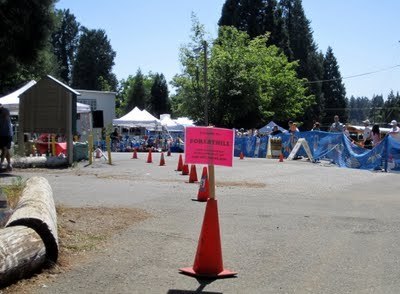
At Western States, your role as a pacer begins at Foresthill, the mile 62 aid station which is also the primary access point for crew and spectators throughout the entire course. I got there early enough to sit and watch the front runners come through before grabbing a quick nap in the grass later in the afternoon.
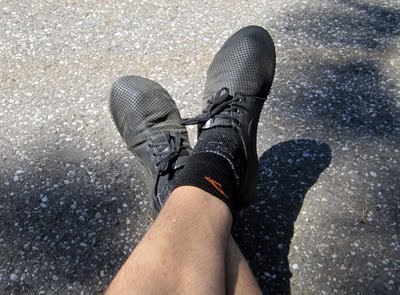 It was while sitting on the side of the road next to my bib number and hydration pack that that I had one of the most memorable conversations of the day, courtesy of a girl in a Montrail Running Team shirt who was staring at my RunAmoc Dashes:
It was while sitting on the side of the road next to my bib number and hydration pack that that I had one of the most memorable conversations of the day, courtesy of a girl in a Montrail Running Team shirt who was staring at my RunAmoc Dashes:
Montrail girl: You're not going to pace somebody in those shoes, are you?
Me: Actually … yeah. I am.
(long pause)
Montrail girl: No, seriously.
Me: Seriously.
Montrail girl: So what are those, anyway?
I started my little spiel about Soft Star and the whole minimalist thing, but I'm pretty sure she lost interest about 30 seconds in. I guess I'll just consider that to be planting the seed, and let someone else cultivate it later on.
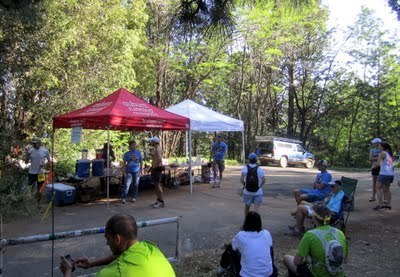 Pacers have the option of running 1.6 miles up the course to the Bath Road aid station to meet their runners a little bit ahead of Foresthill. For some reason the road to Bath left me a little more tired than I had anticipated, but I figured I probably shouldn't complain about that to Gretchen when I saw her, seeing as how she had just run 60 miles through the mountains to get here.
Pacers have the option of running 1.6 miles up the course to the Bath Road aid station to meet their runners a little bit ahead of Foresthill. For some reason the road to Bath left me a little more tired than I had anticipated, but I figured I probably shouldn't complain about that to Gretchen when I saw her, seeing as how she had just run 60 miles through the mountains to get here.
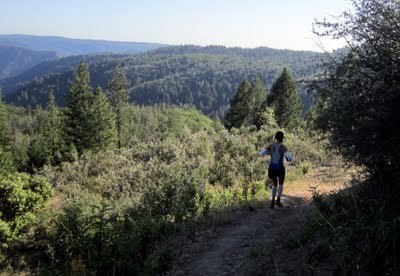 After she emerged from the trail, Gretchen gave me a quick status report (the short version: she felt great) on our way to Foresthill, where she made a quick aid station stop, and we set off down the beautiful, gently sloping single track on our long descent towards the American River crossing at mile 78.
After she emerged from the trail, Gretchen gave me a quick status report (the short version: she felt great) on our way to Foresthill, where she made a quick aid station stop, and we set off down the beautiful, gently sloping single track on our long descent towards the American River crossing at mile 78.
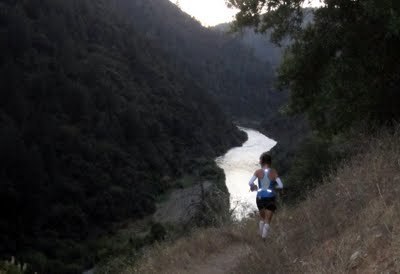 Gretchen had run the course fast enough that nearly all of our journey to the river was done without headlamps. We saw the river almost the whole way down, and enjoyed an evening chorus of frogs, ducks, and crickets alongside sound of the flowing water. It was just another night to them, and their symphony represented life going on all around us, regardless of what happened in this crazy race. That seemed comforting – and it may have been my favorite part of the night.
Gretchen had run the course fast enough that nearly all of our journey to the river was done without headlamps. We saw the river almost the whole way down, and enjoyed an evening chorus of frogs, ducks, and crickets alongside sound of the flowing water. It was just another night to them, and their symphony represented life going on all around us, regardless of what happened in this crazy race. That seemed comforting – and it may have been my favorite part of the night.
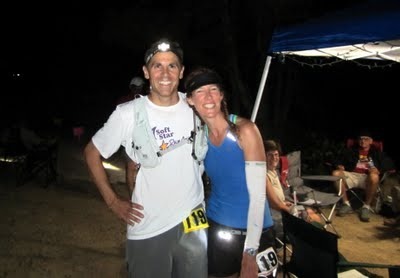 One thing that really impressed me about Gretchen was that she almost never stopped moving. She was in and out of aid stations in a flash, and whenever I took a few extra seconds for pictures or to make gear adjustments, she was gone. This photo just before the river crossing was the only time she willingly stopped – and even then, as I was checking the photo and loading my camera back into my pack, I soon heard an aid station volunteer shout, Hey, dude – your runner's already left! I scrambled down the riverbank to catch up, and was barely able to jump in the raft before Gretchen pushed us away from shore. She claims she wouldn't have left without me. I'm not so sure.
One thing that really impressed me about Gretchen was that she almost never stopped moving. She was in and out of aid stations in a flash, and whenever I took a few extra seconds for pictures or to make gear adjustments, she was gone. This photo just before the river crossing was the only time she willingly stopped – and even then, as I was checking the photo and loading my camera back into my pack, I soon heard an aid station volunteer shout, Hey, dude – your runner's already left! I scrambled down the riverbank to catch up, and was barely able to jump in the raft before Gretchen pushed us away from shore. She claims she wouldn't have left without me. I'm not so sure.
 Brown's Bar aid station at mile 90 is a cross between a cool Halloween party and a cozy New Year's Eve bash. When we pulled into the aid station, I commented to Mr. Raggedy Ann that I was working fairly hard to keep up with my runner. He started to tell me about a race where he paced a runner who eventually dropped him; unfortunately, I never got to hear the end of it, because by the time he was ten seconds into his story, I looked over my shoulder and noticed that Gretchen had vanished.
Brown's Bar aid station at mile 90 is a cross between a cool Halloween party and a cozy New Year's Eve bash. When we pulled into the aid station, I commented to Mr. Raggedy Ann that I was working fairly hard to keep up with my runner. He started to tell me about a race where he paced a runner who eventually dropped him; unfortunately, I never got to hear the end of it, because by the time he was ten seconds into his story, I looked over my shoulder and noticed that Gretchen had vanished.
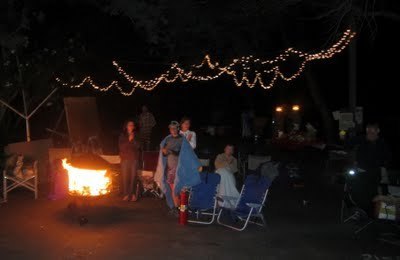 This was a cool touch: in the neighborhood surrounding the Placer High School finish line were a couple groups of intrepid fans who thought pulling an all-nighter to cheer the runners home was a perfectly reasonable idea. The level of enthusiasm that people – both participants and spectators – have for this race is truly admirable.
This was a cool touch: in the neighborhood surrounding the Placer High School finish line were a couple groups of intrepid fans who thought pulling an all-nighter to cheer the runners home was a perfectly reasonable idea. The level of enthusiasm that people – both participants and spectators – have for this race is truly admirable.
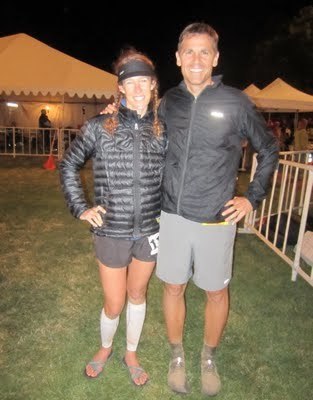 That's part of the intangible benefit I took from this experience as well: admiration for all the runners who competed, and inspiration for when I take on a similar challenge in a few weeks. I enjoyed spending a fun night with a good friend, and I'm hoping that some of her success rubs off on me when it's my turn to tackle 100 miles. It was a privilege for me to be a part of Western States – especially since Gretchen didn't need me any more than I needed a pair of Montrails – and it turned out to be a perfect boost of encouragement and motivation at just the right time.
That's part of the intangible benefit I took from this experience as well: admiration for all the runners who competed, and inspiration for when I take on a similar challenge in a few weeks. I enjoyed spending a fun night with a good friend, and I'm hoping that some of her success rubs off on me when it's my turn to tackle 100 miles. It was a privilege for me to be a part of Western States – especially since Gretchen didn't need me any more than I needed a pair of Montrails – and it turned out to be a perfect boost of encouragement and motivation at just the right time.
Get updates as soon as they're posted! Click here to subscribe to Running and Rambling.
Check out the Running Life book for a collection of our most popular columns.

Of course, there's an intangible benefit to pacing as well, which I'll explain towards the end of the post. In the meantime, I figured I'd share some of my own observations from Gretchen's night while she's dragging her feet to write an official race report.

At Western States, your role as a pacer begins at Foresthill, the mile 62 aid station which is also the primary access point for crew and spectators throughout the entire course. I got there early enough to sit and watch the front runners come through before grabbing a quick nap in the grass later in the afternoon.
 It was while sitting on the side of the road next to my bib number and hydration pack that that I had one of the most memorable conversations of the day, courtesy of a girl in a Montrail Running Team shirt who was staring at my RunAmoc Dashes:
It was while sitting on the side of the road next to my bib number and hydration pack that that I had one of the most memorable conversations of the day, courtesy of a girl in a Montrail Running Team shirt who was staring at my RunAmoc Dashes:Montrail girl: You're not going to pace somebody in those shoes, are you?
Me: Actually … yeah. I am.
(long pause)
Montrail girl: No, seriously.
Me: Seriously.
Montrail girl: So what are those, anyway?
I started my little spiel about Soft Star and the whole minimalist thing, but I'm pretty sure she lost interest about 30 seconds in. I guess I'll just consider that to be planting the seed, and let someone else cultivate it later on.
 Pacers have the option of running 1.6 miles up the course to the Bath Road aid station to meet their runners a little bit ahead of Foresthill. For some reason the road to Bath left me a little more tired than I had anticipated, but I figured I probably shouldn't complain about that to Gretchen when I saw her, seeing as how she had just run 60 miles through the mountains to get here.
Pacers have the option of running 1.6 miles up the course to the Bath Road aid station to meet their runners a little bit ahead of Foresthill. For some reason the road to Bath left me a little more tired than I had anticipated, but I figured I probably shouldn't complain about that to Gretchen when I saw her, seeing as how she had just run 60 miles through the mountains to get here. After she emerged from the trail, Gretchen gave me a quick status report (the short version: she felt great) on our way to Foresthill, where she made a quick aid station stop, and we set off down the beautiful, gently sloping single track on our long descent towards the American River crossing at mile 78.
After she emerged from the trail, Gretchen gave me a quick status report (the short version: she felt great) on our way to Foresthill, where she made a quick aid station stop, and we set off down the beautiful, gently sloping single track on our long descent towards the American River crossing at mile 78. Gretchen had run the course fast enough that nearly all of our journey to the river was done without headlamps. We saw the river almost the whole way down, and enjoyed an evening chorus of frogs, ducks, and crickets alongside sound of the flowing water. It was just another night to them, and their symphony represented life going on all around us, regardless of what happened in this crazy race. That seemed comforting – and it may have been my favorite part of the night.
Gretchen had run the course fast enough that nearly all of our journey to the river was done without headlamps. We saw the river almost the whole way down, and enjoyed an evening chorus of frogs, ducks, and crickets alongside sound of the flowing water. It was just another night to them, and their symphony represented life going on all around us, regardless of what happened in this crazy race. That seemed comforting – and it may have been my favorite part of the night. One thing that really impressed me about Gretchen was that she almost never stopped moving. She was in and out of aid stations in a flash, and whenever I took a few extra seconds for pictures or to make gear adjustments, she was gone. This photo just before the river crossing was the only time she willingly stopped – and even then, as I was checking the photo and loading my camera back into my pack, I soon heard an aid station volunteer shout, Hey, dude – your runner's already left! I scrambled down the riverbank to catch up, and was barely able to jump in the raft before Gretchen pushed us away from shore. She claims she wouldn't have left without me. I'm not so sure.
One thing that really impressed me about Gretchen was that she almost never stopped moving. She was in and out of aid stations in a flash, and whenever I took a few extra seconds for pictures or to make gear adjustments, she was gone. This photo just before the river crossing was the only time she willingly stopped – and even then, as I was checking the photo and loading my camera back into my pack, I soon heard an aid station volunteer shout, Hey, dude – your runner's already left! I scrambled down the riverbank to catch up, and was barely able to jump in the raft before Gretchen pushed us away from shore. She claims she wouldn't have left without me. I'm not so sure. Brown's Bar aid station at mile 90 is a cross between a cool Halloween party and a cozy New Year's Eve bash. When we pulled into the aid station, I commented to Mr. Raggedy Ann that I was working fairly hard to keep up with my runner. He started to tell me about a race where he paced a runner who eventually dropped him; unfortunately, I never got to hear the end of it, because by the time he was ten seconds into his story, I looked over my shoulder and noticed that Gretchen had vanished.
Brown's Bar aid station at mile 90 is a cross between a cool Halloween party and a cozy New Year's Eve bash. When we pulled into the aid station, I commented to Mr. Raggedy Ann that I was working fairly hard to keep up with my runner. He started to tell me about a race where he paced a runner who eventually dropped him; unfortunately, I never got to hear the end of it, because by the time he was ten seconds into his story, I looked over my shoulder and noticed that Gretchen had vanished. This was a cool touch: in the neighborhood surrounding the Placer High School finish line were a couple groups of intrepid fans who thought pulling an all-nighter to cheer the runners home was a perfectly reasonable idea. The level of enthusiasm that people – both participants and spectators – have for this race is truly admirable.
This was a cool touch: in the neighborhood surrounding the Placer High School finish line were a couple groups of intrepid fans who thought pulling an all-nighter to cheer the runners home was a perfectly reasonable idea. The level of enthusiasm that people – both participants and spectators – have for this race is truly admirable. That's part of the intangible benefit I took from this experience as well: admiration for all the runners who competed, and inspiration for when I take on a similar challenge in a few weeks. I enjoyed spending a fun night with a good friend, and I'm hoping that some of her success rubs off on me when it's my turn to tackle 100 miles. It was a privilege for me to be a part of Western States – especially since Gretchen didn't need me any more than I needed a pair of Montrails – and it turned out to be a perfect boost of encouragement and motivation at just the right time.
That's part of the intangible benefit I took from this experience as well: admiration for all the runners who competed, and inspiration for when I take on a similar challenge in a few weeks. I enjoyed spending a fun night with a good friend, and I'm hoping that some of her success rubs off on me when it's my turn to tackle 100 miles. It was a privilege for me to be a part of Western States – especially since Gretchen didn't need me any more than I needed a pair of Montrails – and it turned out to be a perfect boost of encouragement and motivation at just the right time. Get updates as soon as they're posted! Click here to subscribe to Running and Rambling.
Check out the Running Life book for a collection of our most popular columns.

Published on June 30, 2011 21:49
June 29, 2011
Patagonia Pau Shoe Review
In previous posts I've lamented how relatively limited the formal minimalist footwear market is compared to the myriad of athletic and/or sandal styles available. Today's review features another addition to the "dressy minimal" category, and happens to be from one of my favorite companies: Patagonia, whose name is almost synonymous with high performance and social responsibility.
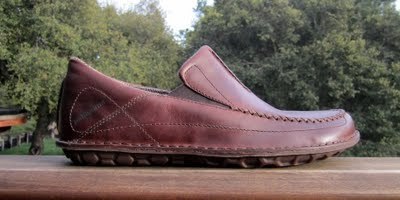
Patagonia Pau
Patagonia isn't generally known for formal wear, and the men's Pau shoe has a styling that could pass equally well for casual outings as it would as office attire. It also lives up to the company's reputation as an eco-conscious manufacturer, even earning an "Eco-Star" designation from Outside magazine for its green construction elements. In the interest of full disclosure, it takes a little bit of resourcefulness to make the Pau a true minimalist shoe; I'll explain what I mean in a minute. For now, let's get to the review.
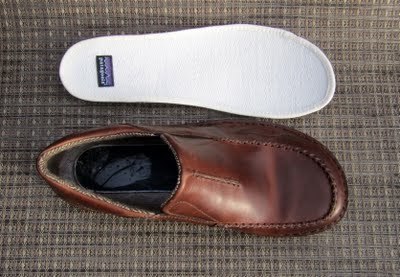
Leather upper and removable insole
Uppers of the Pau are made from full grain leather, available in Walnut (my version) or a very dark Velvet Brown. There's a thin liner of Dri-Lex merino wool, a naturally wicking fabric that provides comfort even if you're going sockless. Waterproof stretch gussets on either side of the tongue make the shoe very easy to slip on and off. The toe box is naturally roomy, with plenty of space for your toes to spread apart.
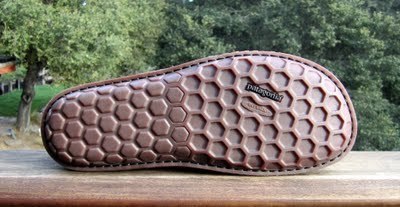
Hevea rubber outsole
Green construction is most evident in the outsole, which is made of 70% hevea milk latex, a sustainable resource derived from the tropical hevea tree; you can read here about how the tree's milk is processed into rubber. The outsole has a honeycomb pattern similar to VivoBarefoot models, except that the rear foot honeycombs are convex while the forefoot ones are concave. Thickness of the outsole is 12mm, which is thicker than the VivoBarefoot Oak but slightly thinner than Merrell's Tough Glove.
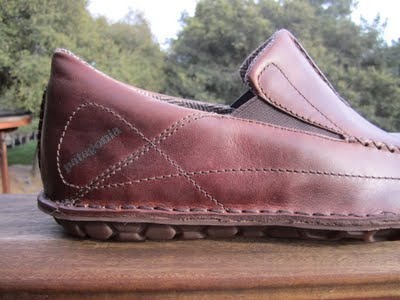
Opanka stitching around outsole
Another eco-friendly production method is known as Opanka stitching, which is a European method of shoe construction where the outsole is hand sewn onto the upper, rather than glued with chemical adhesives. This stitching is evident around the entire outsole as well as the top of the upper and the back of the heel. It's a very durable construction method that minimizes the use of toxic byproducts.
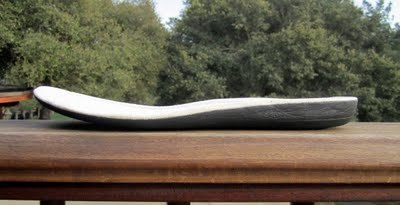
Insole with one-inch heel
Here's what I mean about the Pau not being a true minimalist shoe: the standard issue model comes with an insole that is 1" high in the heel and tapers to the forefoot. However, the insole is removable, and that was the first thing I did after receiving the shoes. There's no additional midsole layer, so once the insole is out, you've only got the layer of hevea rubber between you and the pavement. You could also put a thin, flat insole - such as the one Patagonia uses in its Advocate moccasin - in place of the thick one on the Pau if necessary for comfort or to make up for the fit differential (see below).
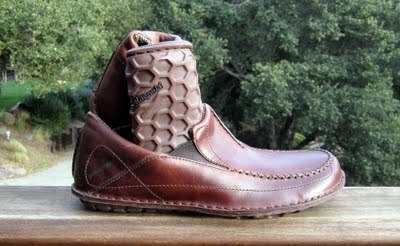
Perfectly flexible with insole removed
Once the insole is removed, the Pau is completely flat and completely flexible, and functions just like a true minimalist shoe. However, removing the insole also changes the overall fit; the toe box is roomier to the point of being excessive, and the collar will be 1" higher on your ankle. My recommendation is to get at least a half-size smaller shoe than you normally wear, which will compensate for both the taller ankle height and the roomier toe box.
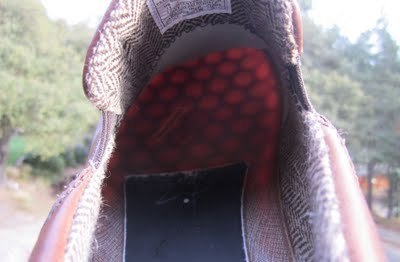
Translucent forefoot outsole
Ground feel with the insole removed is quite good, especially through the forefoot, where the hevea outsole is so thin as to be translucent. Overall weight of the Pau is 9oz (slightly less without the insole), which is comparable to the VivoBarefoot Oak but heavier than Merrell's Tough Glove. Patagonia claims that the hevea material is highly durable and puncture-resistant, and I haven't had any problems that would indicate otherwise.
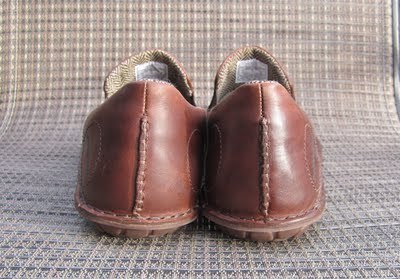
More Opanka!
For a product that wasn't specifically designed as a barefoot shoe, the Pau comes awfully close to meeting all the requirements that minimalists look for. It also makes a nice addition to the gradually expanding lineup of natural footwear that is suitable for professional use or formal occasions.
The Patagonia Pau retails for $130 from the company website and is discounted to $119 at Amazon.com.
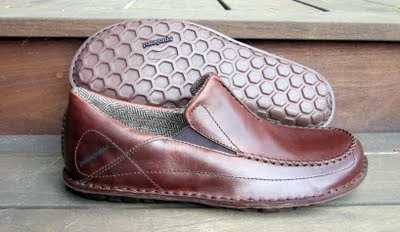
*Product provided by Patagonia
**See other product reviews on sidebar at right. If you have a product you'd like reviewed, contact me at info@runningandrambling.com.
Get updates as soon as they're posted! Click here to subscribe to Running and Rambling.
Check out the Running Life book for a collection of our most popular columns.


Patagonia Pau
Patagonia isn't generally known for formal wear, and the men's Pau shoe has a styling that could pass equally well for casual outings as it would as office attire. It also lives up to the company's reputation as an eco-conscious manufacturer, even earning an "Eco-Star" designation from Outside magazine for its green construction elements. In the interest of full disclosure, it takes a little bit of resourcefulness to make the Pau a true minimalist shoe; I'll explain what I mean in a minute. For now, let's get to the review.

Leather upper and removable insole
Uppers of the Pau are made from full grain leather, available in Walnut (my version) or a very dark Velvet Brown. There's a thin liner of Dri-Lex merino wool, a naturally wicking fabric that provides comfort even if you're going sockless. Waterproof stretch gussets on either side of the tongue make the shoe very easy to slip on and off. The toe box is naturally roomy, with plenty of space for your toes to spread apart.

Hevea rubber outsole
Green construction is most evident in the outsole, which is made of 70% hevea milk latex, a sustainable resource derived from the tropical hevea tree; you can read here about how the tree's milk is processed into rubber. The outsole has a honeycomb pattern similar to VivoBarefoot models, except that the rear foot honeycombs are convex while the forefoot ones are concave. Thickness of the outsole is 12mm, which is thicker than the VivoBarefoot Oak but slightly thinner than Merrell's Tough Glove.

Opanka stitching around outsole
Another eco-friendly production method is known as Opanka stitching, which is a European method of shoe construction where the outsole is hand sewn onto the upper, rather than glued with chemical adhesives. This stitching is evident around the entire outsole as well as the top of the upper and the back of the heel. It's a very durable construction method that minimizes the use of toxic byproducts.

Insole with one-inch heel
Here's what I mean about the Pau not being a true minimalist shoe: the standard issue model comes with an insole that is 1" high in the heel and tapers to the forefoot. However, the insole is removable, and that was the first thing I did after receiving the shoes. There's no additional midsole layer, so once the insole is out, you've only got the layer of hevea rubber between you and the pavement. You could also put a thin, flat insole - such as the one Patagonia uses in its Advocate moccasin - in place of the thick one on the Pau if necessary for comfort or to make up for the fit differential (see below).

Perfectly flexible with insole removed
Once the insole is removed, the Pau is completely flat and completely flexible, and functions just like a true minimalist shoe. However, removing the insole also changes the overall fit; the toe box is roomier to the point of being excessive, and the collar will be 1" higher on your ankle. My recommendation is to get at least a half-size smaller shoe than you normally wear, which will compensate for both the taller ankle height and the roomier toe box.

Translucent forefoot outsole
Ground feel with the insole removed is quite good, especially through the forefoot, where the hevea outsole is so thin as to be translucent. Overall weight of the Pau is 9oz (slightly less without the insole), which is comparable to the VivoBarefoot Oak but heavier than Merrell's Tough Glove. Patagonia claims that the hevea material is highly durable and puncture-resistant, and I haven't had any problems that would indicate otherwise.

More Opanka!
For a product that wasn't specifically designed as a barefoot shoe, the Pau comes awfully close to meeting all the requirements that minimalists look for. It also makes a nice addition to the gradually expanding lineup of natural footwear that is suitable for professional use or formal occasions.
The Patagonia Pau retails for $130 from the company website and is discounted to $119 at Amazon.com.

*Product provided by Patagonia
**See other product reviews on sidebar at right. If you have a product you'd like reviewed, contact me at info@runningandrambling.com.
Get updates as soon as they're posted! Click here to subscribe to Running and Rambling.
Check out the Running Life book for a collection of our most popular columns.

Published on June 29, 2011 20:48
June 27, 2011
Soft Star Moc3 Review
Every now and then I wonder if there isn't some larger force at play in this whole minimalist footwear renaissance; while it might not quite approach divine intervention, there's certainly been a healthy dose of serendipity along the way.
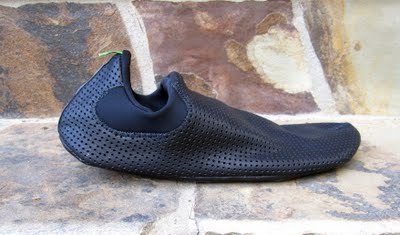
Soft Star Moc3
Case in point is the new Soft Star Moc3, which is as much the story of the designer as it is of the company. According to the video at the end of my Moc3 preview post, this new model was born when one of the most insightful shoe designers in the world happened to walk into the workshop where Soft Star elves were striving to further expand and enhance their already outstanding natural footwear inventory.
The designer is Mike Friton, and if you were drafting the ideal resume for a minimalist shoe designer, you probably couldn't invent a better one than Mike's. He ran competitively at the University of Oregon, and had a student job moonlighting in Bill Bowerman's shoe lab – you know, the one that would eventually become Nike - by hand crafting shoes for elite athletes. He earned a degree in anthropology and continued working with the Nike lab for many years, with a primary focus on footwear innovation, including development of the original Nike Free. Mike left Nike a few years ago, and is currently teaching shoe design at the Portland Art Institute.
Part of Mike's anthropology research involved studying different styles of shoe construction all over the world, and from the very beginning, he's promoted barefoot running while trying to convince the traditional shoe establishment that minimal, natural construction was of the utmost importance. During an e-mail exchange I had with him recently, he elaborated on this point:
*
I made many trips to the Oregon dunes where we would run barefoot and often ran strides barefoot on the infield of the track. Many of the great coaches of my time (Bowerman, Lydiard) promoted barefoot running. I think the inspiration that led me to minimal footwear was from my running experience and doing research in medical journals. There are many studies going back over 60 years that cite lower incidence of knee and hip problems with cultures that are barefoot or in minimal footwear. I began looking at these journals over 25 years ago.
In many meetings with my footwear colleagues I have stated that "shoes are bad for you". This used to be met with blank looks until I cited the articles I had read. It has now become acceptable and even cool to talk about, but the problem is that every company is jumping on the wagon but few really understand the issues related to footwear construction. Most are just making thin midsoles and calling them minimalist. The real issue is making footwear dynamic; shoes should follow the foot, not the other way around.
*
Of course, Mike's philosophy and design skills are only half of the equation – the other half is the workshop he happened across one day, where Soft Star has loyally dedicated itself to minimal construction and natural foot function from the time Mike was running laps at the U of O. The skill sets of the designer and the manufacturer complement each other perfectly, and the resulting product is something that's both truly innovative and highly functional.
An executive summary of the Moc3 would describe it as footwear made of neoprene, leather, and a thin rubber outsole; however, it's also one of those products that's hard to place in a single category. Since it's made by Soft Star, my initial tendency was to call it a moccasin, although it looks and feels more like a bedroom slipper. The website calls it a shoe, and it's durable enough to handle almost any outdoor activity you can imagine, but when it's on your foot it seems like you're wearing little more than a pair of thick socks. And of course, there's more to its construction than meets the eye.

Perforated leather upper with breathe-o-prene lining
Like my favorite RunAmoc Lites, the Moc3 uses perforated leather on the majority of the upper – but the major distinction in these uppers is what's underneath. The entire sockliner is composed of a 4-way stretch material called breathe-o-prene that is used in athletic gear like shoe insoles and injury prevention braces. Breathe-o-prene pulls moisture away from the skin to help keep your foot dry, and has an open cell construction that ventilates the foot very effectively. However, it still forms a solid enough barrier layer to keep most dust and grit from reaching your toes through the perforated leather.
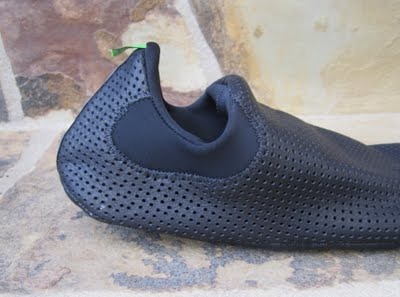
More breathe-o-prene at ankle opening for stretch entry
When I first learned that a neoprene-like material would be used for these, my immediate concern was whether the Moc3 would begin to stink after a while. Soft Star advertises this model as odor-resistant, and I have to say that thus far I've been pleasantly surprised at how well they resist stench. I might change my mind in another hundred miles or so – the most I have on a single pair so far is about 70 – but for the time being they certainly have better odor control than most of my other minimalist options, including my trusty RunAmocs.
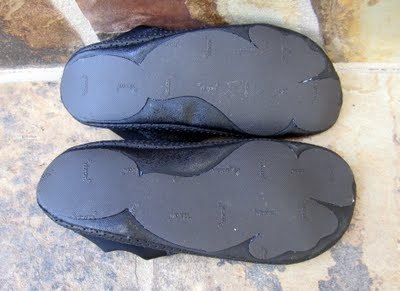
2mm Vibram street outsole welded to T-Rex fabric
The most distinctive aspect of the Moc3 is the outsole, which evolved from a "podded" look to a single piece of Vibram 2mm rubber shaped to coincide with natural ground contact areas. There's no last to this shoe whatsoever, so the entire bottom surface can contour to your foot. The outsole is welded onto a very thin, completely flexible layer of T-Rex material that Soft Star uses on the bottom of its grippy Roo slippers. Thanks to its outstanding flexibility, the Moc3 accomplishes Mike Friton's goal of dynamic footwear that moves with the foot in every position and in all directions; there's no structural element of this shoe that prevents your foot from moving 100% naturally.
In my preview post I mentioned that ground feel with the Moc3 is better than anything I've ever worn – in fact, it's so pure that I actually shy away from using them sometimes. If I'm doing a run on super-rocky or jagged terrain, I have to slow down a lot more in the Moc3 than I do with my 5mm-trail-outsoled RunAmocs. I wore the Moc3 for one 50K trail run, and my feet got beat up a lot worse than they typically do in FiveFingers or RunAmocs. The product webpage says they're suitable for dirt and moderate trails, and that "tough-footed" barefooters can use them on technical trails. So perhaps I just need to toughen up – but I'd still classify the Moc3 as a street, fire road, and groomed or moderately technical trail model.
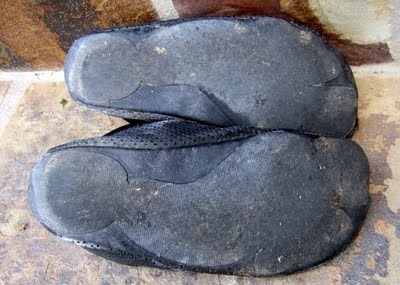
Outsoles after about 70 miles
The net result of combining a soft foot-hugging upper, a completely thin and flexible outsole, and less than 5oz of weight per shoe is this: it feels like you're not wearing a shoe at all. Part of the reason I'm somewhat confused about calling the Moc3 a shoe, slipper, moc, or sock is that it doesn't really fit any of those things; it really just feels like an extension of your foot with some minor reinforcement.
Early in the testing process, I realized that this was one of the most comfortable pieces of footwear I own, even rivaling my beloved Roo slippers. I was so pleased with their comfort that on more than one occasion, when I had to return a prototype to Soft Star for inspection, I included a note asking if I could have them back afterward – even the early models that were falling apart in places. I now have two pairs of Moc3s that I use in heavy rotation: a dedicated running pair that gets muddy and sweaty, and a secondary pair that I use for lounging around the house or wearing casually.
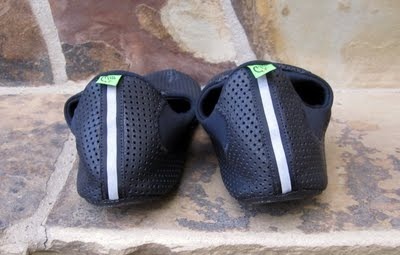
Reflective striping on the heel
Despite my infatuation with them, there are a few noteworthy disclaimers about the Moc3 to point out, especially for returning Soft Star customers who are used to a "have it your way" ordering process. Things are slightly different with this model in the following ways:
* As of its initial release, there isn't a smooth leather option for the Moc3, and you can't customize your colors and materials like you can with other models.
* Because of the thinness and flexibility of the undersurface, the 5mm trail outsole isn't available on the Moc3. I tested a prototype with the trail outsole, and the overall feel was fairly awkward, with my foot sliding off the edge of the outsole quite a bit. This is something else that may be revisited at some point, but for the time being, only thin is in.

No laces, straps, or other means of adjustment
* Like other Soft Star models, the Moc3 is only available in whole sizes, but since there's no lacing system or any other way to adjust the tension around the ankle or through the midfoot, if you're between sizes on these, you may have a difficult fit. Sizing up might give you a looser fit through the midfoot, and sizing down might cause your toes to touch the front seam.
If you're OK with those caveats, the Moc3 is really an extraordinary shoe (or moc, or slipper, or whatever you want to call it) that is unlike practically anything else in modern minimalist footwear. It retails for $94 from the Soft Star website.
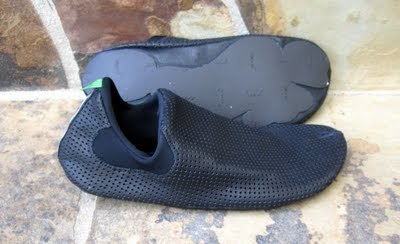
Related reviews:
Soft Star Original RunAmoc
Soft Star RunAmoc Dash
Soft Star Roo slippers
*Product provided by Soft Star Shoes
**See other product reviews on sidebar at right. If you have a product you'd like reviewed, contact me at info@runningandrambling.com.
Get updates as soon as they're posted! Click here to subscribe to Running and Rambling.
Check out the Running Life book for a collection of our most popular columns.


Soft Star Moc3
Case in point is the new Soft Star Moc3, which is as much the story of the designer as it is of the company. According to the video at the end of my Moc3 preview post, this new model was born when one of the most insightful shoe designers in the world happened to walk into the workshop where Soft Star elves were striving to further expand and enhance their already outstanding natural footwear inventory.
The designer is Mike Friton, and if you were drafting the ideal resume for a minimalist shoe designer, you probably couldn't invent a better one than Mike's. He ran competitively at the University of Oregon, and had a student job moonlighting in Bill Bowerman's shoe lab – you know, the one that would eventually become Nike - by hand crafting shoes for elite athletes. He earned a degree in anthropology and continued working with the Nike lab for many years, with a primary focus on footwear innovation, including development of the original Nike Free. Mike left Nike a few years ago, and is currently teaching shoe design at the Portland Art Institute.
Part of Mike's anthropology research involved studying different styles of shoe construction all over the world, and from the very beginning, he's promoted barefoot running while trying to convince the traditional shoe establishment that minimal, natural construction was of the utmost importance. During an e-mail exchange I had with him recently, he elaborated on this point:
*
I made many trips to the Oregon dunes where we would run barefoot and often ran strides barefoot on the infield of the track. Many of the great coaches of my time (Bowerman, Lydiard) promoted barefoot running. I think the inspiration that led me to minimal footwear was from my running experience and doing research in medical journals. There are many studies going back over 60 years that cite lower incidence of knee and hip problems with cultures that are barefoot or in minimal footwear. I began looking at these journals over 25 years ago.
In many meetings with my footwear colleagues I have stated that "shoes are bad for you". This used to be met with blank looks until I cited the articles I had read. It has now become acceptable and even cool to talk about, but the problem is that every company is jumping on the wagon but few really understand the issues related to footwear construction. Most are just making thin midsoles and calling them minimalist. The real issue is making footwear dynamic; shoes should follow the foot, not the other way around.
*
Of course, Mike's philosophy and design skills are only half of the equation – the other half is the workshop he happened across one day, where Soft Star has loyally dedicated itself to minimal construction and natural foot function from the time Mike was running laps at the U of O. The skill sets of the designer and the manufacturer complement each other perfectly, and the resulting product is something that's both truly innovative and highly functional.
An executive summary of the Moc3 would describe it as footwear made of neoprene, leather, and a thin rubber outsole; however, it's also one of those products that's hard to place in a single category. Since it's made by Soft Star, my initial tendency was to call it a moccasin, although it looks and feels more like a bedroom slipper. The website calls it a shoe, and it's durable enough to handle almost any outdoor activity you can imagine, but when it's on your foot it seems like you're wearing little more than a pair of thick socks. And of course, there's more to its construction than meets the eye.

Perforated leather upper with breathe-o-prene lining
Like my favorite RunAmoc Lites, the Moc3 uses perforated leather on the majority of the upper – but the major distinction in these uppers is what's underneath. The entire sockliner is composed of a 4-way stretch material called breathe-o-prene that is used in athletic gear like shoe insoles and injury prevention braces. Breathe-o-prene pulls moisture away from the skin to help keep your foot dry, and has an open cell construction that ventilates the foot very effectively. However, it still forms a solid enough barrier layer to keep most dust and grit from reaching your toes through the perforated leather.

More breathe-o-prene at ankle opening for stretch entry
When I first learned that a neoprene-like material would be used for these, my immediate concern was whether the Moc3 would begin to stink after a while. Soft Star advertises this model as odor-resistant, and I have to say that thus far I've been pleasantly surprised at how well they resist stench. I might change my mind in another hundred miles or so – the most I have on a single pair so far is about 70 – but for the time being they certainly have better odor control than most of my other minimalist options, including my trusty RunAmocs.

2mm Vibram street outsole welded to T-Rex fabric
The most distinctive aspect of the Moc3 is the outsole, which evolved from a "podded" look to a single piece of Vibram 2mm rubber shaped to coincide with natural ground contact areas. There's no last to this shoe whatsoever, so the entire bottom surface can contour to your foot. The outsole is welded onto a very thin, completely flexible layer of T-Rex material that Soft Star uses on the bottom of its grippy Roo slippers. Thanks to its outstanding flexibility, the Moc3 accomplishes Mike Friton's goal of dynamic footwear that moves with the foot in every position and in all directions; there's no structural element of this shoe that prevents your foot from moving 100% naturally.
In my preview post I mentioned that ground feel with the Moc3 is better than anything I've ever worn – in fact, it's so pure that I actually shy away from using them sometimes. If I'm doing a run on super-rocky or jagged terrain, I have to slow down a lot more in the Moc3 than I do with my 5mm-trail-outsoled RunAmocs. I wore the Moc3 for one 50K trail run, and my feet got beat up a lot worse than they typically do in FiveFingers or RunAmocs. The product webpage says they're suitable for dirt and moderate trails, and that "tough-footed" barefooters can use them on technical trails. So perhaps I just need to toughen up – but I'd still classify the Moc3 as a street, fire road, and groomed or moderately technical trail model.

Outsoles after about 70 miles
The net result of combining a soft foot-hugging upper, a completely thin and flexible outsole, and less than 5oz of weight per shoe is this: it feels like you're not wearing a shoe at all. Part of the reason I'm somewhat confused about calling the Moc3 a shoe, slipper, moc, or sock is that it doesn't really fit any of those things; it really just feels like an extension of your foot with some minor reinforcement.
Early in the testing process, I realized that this was one of the most comfortable pieces of footwear I own, even rivaling my beloved Roo slippers. I was so pleased with their comfort that on more than one occasion, when I had to return a prototype to Soft Star for inspection, I included a note asking if I could have them back afterward – even the early models that were falling apart in places. I now have two pairs of Moc3s that I use in heavy rotation: a dedicated running pair that gets muddy and sweaty, and a secondary pair that I use for lounging around the house or wearing casually.

Reflective striping on the heel
Despite my infatuation with them, there are a few noteworthy disclaimers about the Moc3 to point out, especially for returning Soft Star customers who are used to a "have it your way" ordering process. Things are slightly different with this model in the following ways:
* As of its initial release, there isn't a smooth leather option for the Moc3, and you can't customize your colors and materials like you can with other models.
* Because of the thinness and flexibility of the undersurface, the 5mm trail outsole isn't available on the Moc3. I tested a prototype with the trail outsole, and the overall feel was fairly awkward, with my foot sliding off the edge of the outsole quite a bit. This is something else that may be revisited at some point, but for the time being, only thin is in.

No laces, straps, or other means of adjustment
* Like other Soft Star models, the Moc3 is only available in whole sizes, but since there's no lacing system or any other way to adjust the tension around the ankle or through the midfoot, if you're between sizes on these, you may have a difficult fit. Sizing up might give you a looser fit through the midfoot, and sizing down might cause your toes to touch the front seam.
If you're OK with those caveats, the Moc3 is really an extraordinary shoe (or moc, or slipper, or whatever you want to call it) that is unlike practically anything else in modern minimalist footwear. It retails for $94 from the Soft Star website.

Related reviews:
Soft Star Original RunAmoc
Soft Star RunAmoc Dash
Soft Star Roo slippers
*Product provided by Soft Star Shoes
**See other product reviews on sidebar at right. If you have a product you'd like reviewed, contact me at info@runningandrambling.com.
Get updates as soon as they're posted! Click here to subscribe to Running and Rambling.
Check out the Running Life book for a collection of our most popular columns.

Published on June 27, 2011 20:43
June 26, 2011
Random Shots of Beauty
One of the most coveted sights in ultrarunning: the Placer High School track in Auburn, CA, as seen under the lights in the dark early morning that accompanies a sub-24-hour finish at Western States:
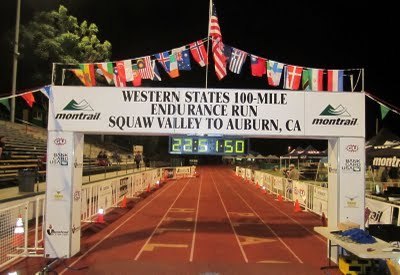
If you can't see this scene as a runner, the next best thing might be seeing it as a pacer, and knowing that your runner just completed a truly epic accomplishment.
I'll follow up on this briefly a bit later on ... but for now, it's time to get some rest.
Get updates as soon as they're posted! Click here to subscribe to Running and Rambling.
Check out the Running Life book for a collection of our most popular columns.


If you can't see this scene as a runner, the next best thing might be seeing it as a pacer, and knowing that your runner just completed a truly epic accomplishment.
I'll follow up on this briefly a bit later on ... but for now, it's time to get some rest.
Get updates as soon as they're posted! Click here to subscribe to Running and Rambling.
Check out the Running Life book for a collection of our most popular columns.

Published on June 26, 2011 17:19
June 23, 2011
Soft Star Moc3 Arrives; Moccasins in National Geographic; Western States Mojo
A few odds and ends to wrap up the week before I head off to one of the biggest trail running events of the year …
*
The much-anticipated Moc3 is now available from the Soft Star website. You can read my Moc3 preview article here, and I'll have an official review published sometime next week.
*
Coincidentally, I happened to be wearing my Moc3s when I was interviewed in May by a writer for the National Geographic Education website, who was putting together an article about ultrarunning. The finished product was published earlier this month, and you can check it out here.
However, before you get too excited, it's important to note that the "Education" arm of National Geographic is an entirely separate entity from the parent magazine, and is geared toward school-aged readers – so instead of "Inspiring the world through exploration and cultural enlightenment", the general vibe is more along the lines of, "Hey, look – grown-ups actually use geography sometimes!" Nevertheless, the article made for a nice read, and the "ultrarunning in moccasins" angle was included an an extra curiosity – or as one of the Soft Star Elves wrote to me, They make you out to be slightly crazy. Well, true … but it's not like they had very far to stretch.
*
On Saturday morning I'm headed to Foresthill, CA to participate in the Western States Endurance Run as a pacer for Gretchen, whose running talent I hinted at in my recent Auburn Trail Run report. I'm penciled in to run 38 miles with her, which would normally be a pretty tall order for me; I can only hope that the 62 miles she's running through snow and heat and steep canyons before joining me might put just enough sting in her legs for me to keep up. Either way, it promises to be an interesting night.
You can follow her progress through the day or night on the Western States tracking page; she's runner #119. And if you're looking for extensive previews and reporting on this year's event or updates from the front of the pack on race day, be sure to check out Bryon Powell's outstanding coverage over at iRunFar. Bryon happens to be running the race as well, taking the concept of embedded journalism to a whole new realm.
Since I'll be fairly late in posting over the weekend, here are a couple more Western States-related items for you to chew on. The first is a trailer for a feature-length film that will be released this fall; it's an inside view the epic 3-way battle at last year's WS100, where the 100-mile distance was turned into an honest-to-goodness footrace throughout the final several hours. It remains to be seen whether that scenario was lightning in a bottle or a sign of things to come – but regardless, the race was far and away the coolest story in ultrarunning last year.
"Unbreakable: The Western States 100", by JourneyFilm (click to play):
The second clip is an in-depth (13+-minutes) profile of Geoff Roes, last year's Western States champion, who also happens to be undefeated at the 100-mile distance. Considering his athletic prowess, it's quite remarkable what a mellow, laid-back guy he appears to be. He doesn't exactly display the eye of the tiger, but I guess if you can run like a deer it doesn't much matter. The video is an enlightening look into his training regimen, his mindset during long races, and his overall philosophy about trail running, and is a great portrait of a champion who sometimes seems nearly as reluctant as he is dominant.
"Geoff Roes: Slogging to the Top", by Running Times (click to play):
Whether it's Geoff who crosses the line in Auburn first this weekend or somebody else, Western States will have another remarkable story to tell for everybody who competes this year, and I'm grateful that I'll have a front-row seat to see a part of it in person – just as long as I can keep pace with that girl.
Get updates as soon as they're posted! Click here to subscribe to Running and Rambling.
Check out the Running Life book for a collection of our most popular columns.

*
The much-anticipated Moc3 is now available from the Soft Star website. You can read my Moc3 preview article here, and I'll have an official review published sometime next week.
*
Coincidentally, I happened to be wearing my Moc3s when I was interviewed in May by a writer for the National Geographic Education website, who was putting together an article about ultrarunning. The finished product was published earlier this month, and you can check it out here.
However, before you get too excited, it's important to note that the "Education" arm of National Geographic is an entirely separate entity from the parent magazine, and is geared toward school-aged readers – so instead of "Inspiring the world through exploration and cultural enlightenment", the general vibe is more along the lines of, "Hey, look – grown-ups actually use geography sometimes!" Nevertheless, the article made for a nice read, and the "ultrarunning in moccasins" angle was included an an extra curiosity – or as one of the Soft Star Elves wrote to me, They make you out to be slightly crazy. Well, true … but it's not like they had very far to stretch.
*
On Saturday morning I'm headed to Foresthill, CA to participate in the Western States Endurance Run as a pacer for Gretchen, whose running talent I hinted at in my recent Auburn Trail Run report. I'm penciled in to run 38 miles with her, which would normally be a pretty tall order for me; I can only hope that the 62 miles she's running through snow and heat and steep canyons before joining me might put just enough sting in her legs for me to keep up. Either way, it promises to be an interesting night.
You can follow her progress through the day or night on the Western States tracking page; she's runner #119. And if you're looking for extensive previews and reporting on this year's event or updates from the front of the pack on race day, be sure to check out Bryon Powell's outstanding coverage over at iRunFar. Bryon happens to be running the race as well, taking the concept of embedded journalism to a whole new realm.
Since I'll be fairly late in posting over the weekend, here are a couple more Western States-related items for you to chew on. The first is a trailer for a feature-length film that will be released this fall; it's an inside view the epic 3-way battle at last year's WS100, where the 100-mile distance was turned into an honest-to-goodness footrace throughout the final several hours. It remains to be seen whether that scenario was lightning in a bottle or a sign of things to come – but regardless, the race was far and away the coolest story in ultrarunning last year.
"Unbreakable: The Western States 100", by JourneyFilm (click to play):
The second clip is an in-depth (13+-minutes) profile of Geoff Roes, last year's Western States champion, who also happens to be undefeated at the 100-mile distance. Considering his athletic prowess, it's quite remarkable what a mellow, laid-back guy he appears to be. He doesn't exactly display the eye of the tiger, but I guess if you can run like a deer it doesn't much matter. The video is an enlightening look into his training regimen, his mindset during long races, and his overall philosophy about trail running, and is a great portrait of a champion who sometimes seems nearly as reluctant as he is dominant.
"Geoff Roes: Slogging to the Top", by Running Times (click to play):
Whether it's Geoff who crosses the line in Auburn first this weekend or somebody else, Western States will have another remarkable story to tell for everybody who competes this year, and I'm grateful that I'll have a front-row seat to see a part of it in person – just as long as I can keep pace with that girl.
Get updates as soon as they're posted! Click here to subscribe to Running and Rambling.
Check out the Running Life book for a collection of our most popular columns.

Published on June 23, 2011 20:43

